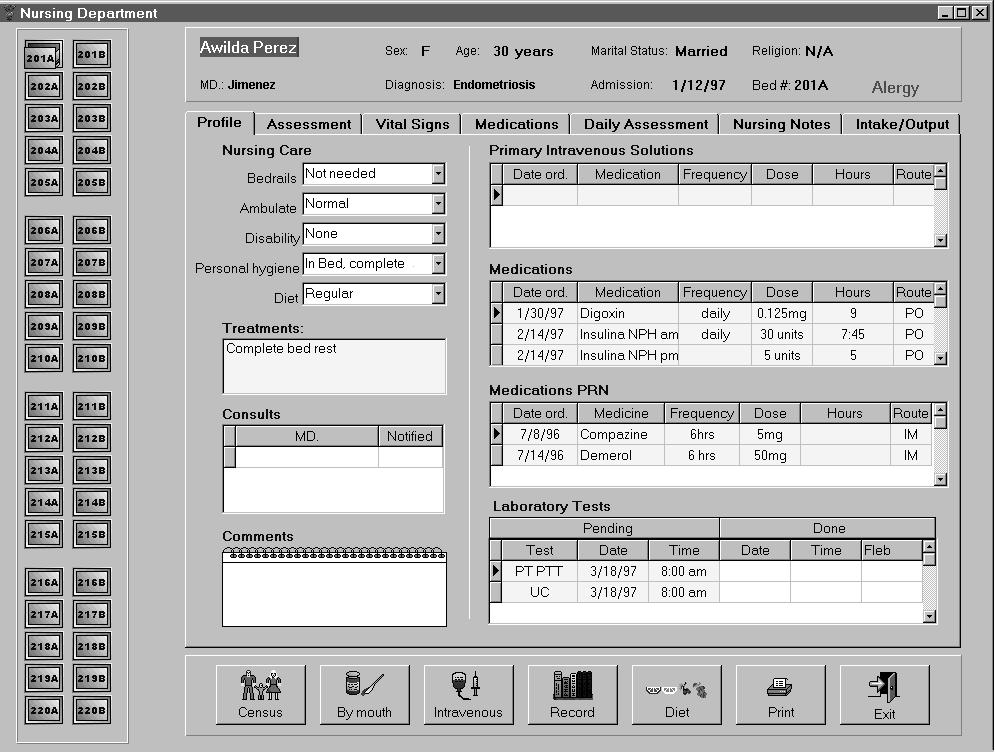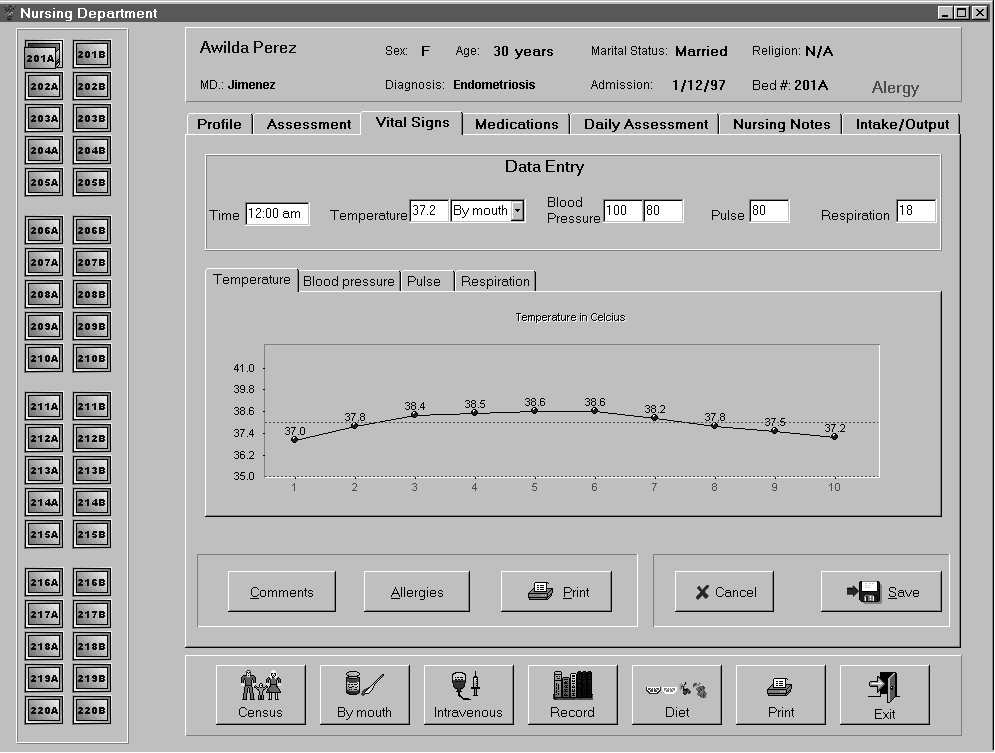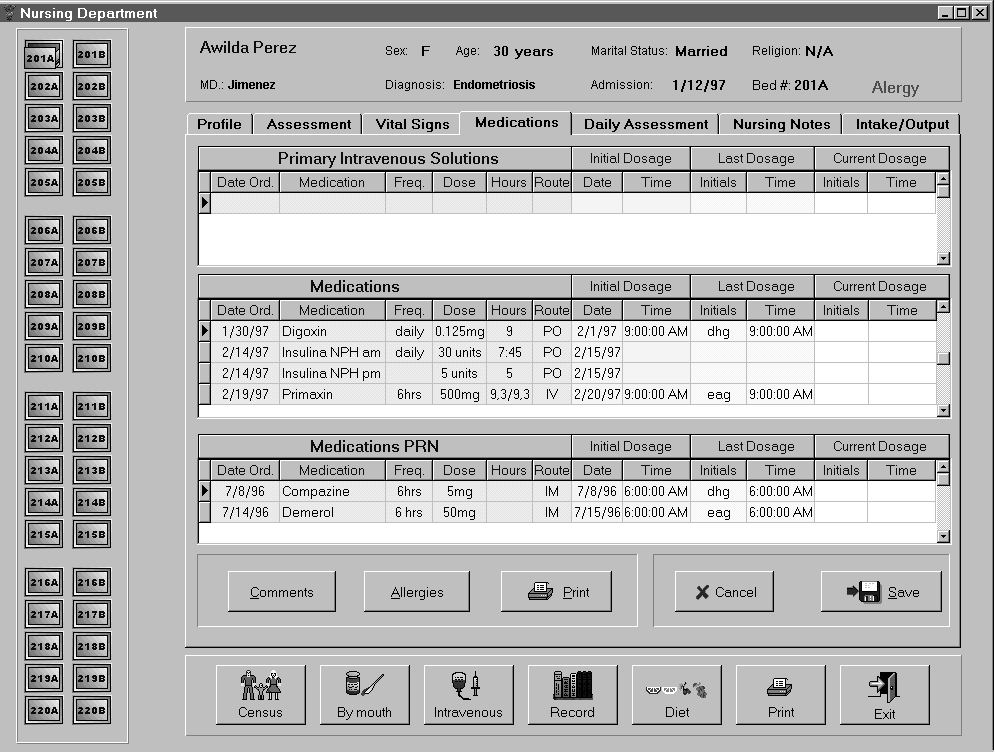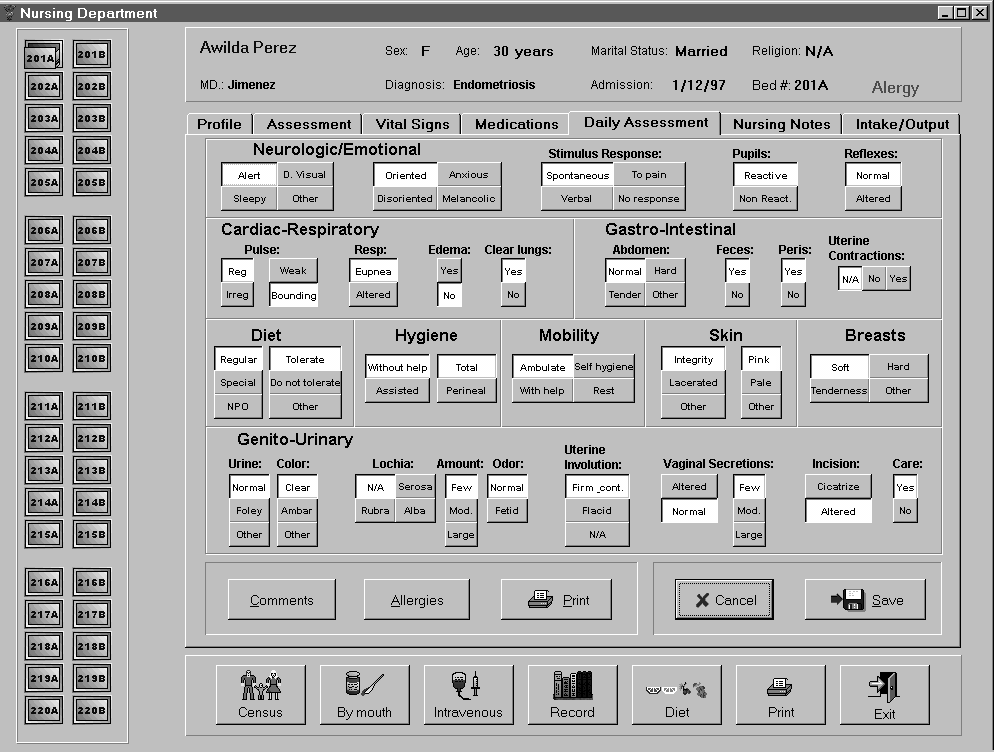
A Computer-Based Patient Record for Improving Nursing Care
Néstor J. Rodríguez, José A. Borges, Domingo Rodríguez, Emily Angarita, Rafael Muñoz
Center for Computing Research and Development
University of Puerto Rico - Mayagüez Campus
Mayagüez, Puerto Rico 00681
nestor@exodo.upr.clu.edu
Abstract
Most of the hospitals in the USA and Puerto Rico keep their patient medical records in paper form. Most of the information that constitutes a patient record is entered by nurses by means of documentation forms. This documentation process takes a significant amount of the nurses time, thus, reducing the time devoted to direct patient care. In this paper we describe the development of a prototype of a computer-based patient record (CPR) system that can improve the quality of nursing care. The improvement in nursing care will be accomplished by providing mechanisms for documentation which reduce human error and the time required to accomplish it, thus, providing more time for direct patient care. The design of the system is based on the principles of human-computer interaction and usability engineering [3].
INTRODUCTION
In spite of all the advantages made in cybernetics, the handling of patient medical records by most health care providers is very inefficient. Most of the hospitals in the USA and Puerto Rico keep their patient medical records in paper form. These health care institutions are not keeping up with technological advances in the computer world. This technological lag can be attributed in part to the costs involved in upgrading from existing systems. A new computer system for handling patient medical records requires an investment in software, hardware, and training of the health care personnel.
To improve the quality of health care, most health care institutions need to make better use of advanced computer technology. The move already has started and there is hope for a more promising future. Various efforts have been made to develop computer-based patient records (CPR) systems [2, 4, 5]. These systems have the objective of supporting patient care and improving the quality of care as well as enhancing the productivity of the health care personnel while reducing the costs of health care delivery[1].
In most hospitals, nurses are responsible for building most of what constitutes the patient record. Most of the documentation on a patient's record is produced as a result of the physicians' orders. These orders are usually processed by the nursing staff who transcribe them into documents such as: laboratory request forms, drug prescription forms, diagnostics tests request forms, etc. In addition, a number of other documents are generated by nurses to report on patients' condition. From our field study we have found that the documentation activities take more than 25% of the nurses' time. Evidently, the time spent documenting is time during which the nurses are precluded from providing direct health care to patients.
After careful study, through field work observations, site visit interviews, and literature reviews, we believe that the process of nursing documentation can be radically improved with the implementation of a computer-based patient medical record which focus on nursing documentation. In this paper we describe the development of a prototype of a CPR system with emphasis on physicians orders processing and nursing documentation. Its design is based on the principles of human-computer interaction and usability engineering [3].
Improvement through Usability Engineering
The use of computers to support patient care is minimal at most hospitals in Puerto Rico and the USA. The systems used by the institutions that do provide some support usually consist of a collection of not very well integrated modules or stand alone applications from a variety of vendors. The best systems provide modules for processing some components of the physician orders such as prescribing medicine, ordering laboratories, and specifying diets. However, few of these systems support nursing documentation. Up-to-date technology such as networks, client/server relational databases and graphical user interfaces is usually absent from these systems.
Most of the existing systems, even the most sophisticated ones, overlook one fundamental aspect, the users. Most systems are character-based systems that require the users to enter the information only through a keyboard and force them to remember alphanumeric codes to specify options and commands. It seems that in the design of these systems most of the effort is placed on the capability and functionality of the system than in its usability. We recognize that it is fundamental to design very capable systems that can improve the processing and maintenance of patient records. However, this should not be achieved at the expense of system usability.
The facility for users to learn how to use a system, the capacity to use it efficiently,
and the subjective satisfaction derived from using a system are usability engineering attributes [3] that have an effect on health care operation costs. A system that is easy to use requires less time for training users. A system that allows the users to achieve a high degree of efficiency in its use facilitates the user to be more productive. A system that increases the subjective user satisfaction motivates the users to use it more frequently. We are strong believers that the cost benefits of designing a usable CPR system make it necessary that the design of the human-computer interface of the system be based on the principles of usability engineering.Any user-centered design requires the involvement of users at all stages of the analysis and design process. The first stage of our project started with visits to health care facilities and interviews with administrators and health care personnel. This process was important to understand the working conditions and environment, define the problems, generate objectives and goals, and get to know the potential users.
The second stage consisted of a task analysis. This involved visits to hospitals, gathering of documentation forms and requirements, and observation of nurses performing their duties. An important aspect of this stage was to identify the usual tasks performed by the nurses and to measure the time it take them to perform each task. This analysis not only provided us with a more detailed understanding of the nurses' work, but also provided us the data to be used for comparison purposes.
After the task analysis we began the development of a prototype of the system. This prototype was developed as a test bed for conducting usability tests on the different modules that will be developed in futures phases. The prototype was developed with Borland's Delphi 2 for Developers. It runs on a Windows NT environment, in a client/server configuration.
During the prototype development process we studied existing documentation forms and applied usability engineering principles on the design of the user interfaces of their computer versions. To determine usability problems early in the design we conducted a heuristic evaluation of the graphical user interface of the system. The objective of a heuristic evaluation is to determine whether the user interface violates well known human-computer interaction design principles that affects its usability [3].
As a result of the heuristic evaluation the prototype was refined. Then, it was demonstrated to a group of nurses from a local hospital who provided suggestion for improvements. The resulting prototype is presented in the following section.
Supporting Nursing Care with a Usable CPR System
Our CPR system has been conceived as a series of integrated modules whose main functions will be the overall improvement of the health care process. These modules will enhance functions such as processing of physicians orders, nursing documentation, laboratory reporting, display of patients' vital sign data, assisting in the training of personnel, generation of data for outcomes research and management studies, and networking among hospitals. Our current work is focused on the modules for entering the physicians orders and nursing documentation.
On our prototype the medical orders are entered directly into a computer by the physicians. These orders will be sent automatically to the corresponding departments. This releases a great deal of time from the nursing staff because the nurses no longer have to transcribe physician orders or deal with the delivery of the different forms to the corresponding departments. Thus, the nurses intervention with the patient record is reduced to the usual nursing documentation that they are required to perform. The system will also help to prevent errors in the documentation process and in the administration of nursing care to the patients.
The prototype provides a physicians interface for entering medical orders, and a nurses interface for nursing documentation. Both are windows-based graphical user interfaces. The physicians interface allows physicians to enter orders for laboratories, drug prescriptions, diets, consultation with other physicians and other procedures.
The nurses interface is presented in figure 1. The key features of the interface are the following:
• A section at the top of the screen that provides demographic information about the patient and other health information.
• A set of buttons at bottom of the screen for accessing general information such as: census information of the ward (incoming, existing and released patients), medicines to be administered on the ward, diets for the patients, and access to patients records in any ward of the hospital.

Figure 1. Graphical User Interface of the CPR Prototype
• Columns of buttons at the left side, one for each bed of the ward. These buttons are provided to allow the nurses an easy access to the documentation forms of each patient.
• A stack of windows at the center of the screen. These windows correspond to the nursing documentation forms associated with a patient.
This interface prototype has been developed in such a way that the users (the nurses) can move easily from patient record to patient record and from documentation form to documentation form. Moving from one to the other only requires a click with a pointing device on an element of the interface. Most of the commands are issued with a mouse and text is entered through keyboard.
The following documentation forms are currently being supported:
Profile- provides general information to the nurses such as care procedures to be followed, and pending laboratories, consultations and medicines to be administered (see figure 1). This form is very useful during changes of nurses shifts because it provides an overview of the patient's condition and the pending nursing procedures or interventions. More detailed information is provided on the other forms. This electronic form requires less information to be entered by the nurses than the current paper form used by local hospitals. On current paper forms each field of information has to be entered manually. In the electronic version the nurses do not have to enter information concerning laboratories, medicines and physician consultations because this information is generated directly from the physician orders entered to the system by the physicians.

Figure 2. The Vital Signs Form
Vital Signs- provides means for entering and graphically displaying vital signs information such as temperature, respiration, blood pressure and heart rate (see figure 2). With the original form the nurses had to plot a dot on a paper chart each time the vitals signs were taken. With the electronic form the vital signs are registered in the system by entering the vitals signs values with the keyboard. This relieves the nurses from having to position a dot in a chart, which is error prone. In addition a plot for each of the vital signs is generated automatically.
Medications- provides means for entering and displaying information about the drugs that have been administered or that are scheduled to be administered to the patient (see figure 3). This electronic version saves a significant amount of time to the nurses because they are no longer required to enter the prescription information. This information is automatically generated from the physicians orders. The only action required by the nurses is to register the time when the drugs is administered to the patient.
Daily Assessment - provides means for entering and displaying information that describes the patients health condition on each of the nurses shifts (see figure 4). The current paper form is very crowded and relies on codes for reporting conditions, which require nurses to memorize them. The electronic version relies on toggle selection buttons for specifying the condition of each entry. Since each condition is visible in the interface, the nurses do not need to remember codes. The information generated with the electronic form is useful in the generation of the nursing diagnosis and nurses notes. There are various conditions that, when selected, will automatically open a window to enter a note in the Nursing Notes form.

Figure 3. The Medications Form

Figure 4. The Daily Assessment Form
Assessment- provides means for entering and displaying information that describes the patient's health condition when he/she is admitted to the hospital. Its interface is very similar to the Daily Assessment form.
Nursing Notes- used for reporting nursing diagnosis, care plans to be followed, actions taken, and special conditions or situations during the nurses intervention with the patient. The notes can be entered directly into the form or indirectly by the selection of special conditions in the Daily Assessment form.
Intake/Output- provides a means for registering and displaying information about the patient's intake and output of fluids.
Future Work
The next stage of the project will be to run usability tests of the prototype with nurses. These tests will allow us to detect functional problems and usability problems that could not be detected in the early stages of the design. Once these problems are fixed, our objective will be to install the system in a ward of a local hospital and gather information to evaluate its effectiveness and its impact in the quality of nursing care provided.
Acknowledgments
For their valuable contribution to the development of this project we like to thank: Eneida Villarrubia and María Mercado from the Obstetrics & Gynecology Department of the Bella Vista Hospital at Mayaguez, Puerto Rico; Zaida Hernández and Luz A. Rodríguez from the Obstetrics & Gynecology Department of the Perea Hospital at Mayaguez, Puerto Rico; Celia R. Colón and Migdalia Laspina from the Nursing Department of the University of Puerto Rico - Mayaguez.
REFERENCES
[1] Institute of Medicine, The Computer-based Patient Record: An Essential Technology for Health Care, R.S. Dick and E.B. Steen, editors, National Academy Press, Washington D.C. (USA), 1991.
[2] Lundy, Michael S., The Computer-Based Patient Record, Managed Care and the Fate of Clinical Outcomes Research, Florida Family Physician, vol. 46, no. 1, 1996.
[3] Neilsen, Jakob, Usability Engineering, Academic Press, Boston, Massachusetts (USA), 1994.
[4] Szolovits, Peter, A Revolution in Electronic Medical Record Systems via the World Wide Web, The Use of Internet and World Wide Web for Telematics in Healthcare Conference, Geneva, Switzerland, 1995.
[5] Wallace, Scott, The Computerized Patient Record, BYTE Magazine, May, 1994.